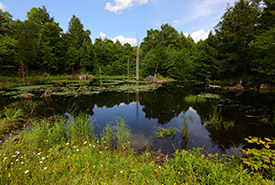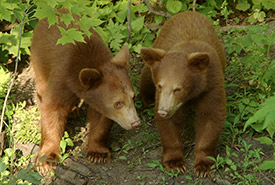Montebello - Kenauk: Saumon (Kinonge) river valley, perspectives on a natural historical treasure

Kenauk, Quebec (Photo by Mike Dembeck)
The Nature Conservancy of Canada (NCC) and the Kenauk Institute are partnering in a unique campaign to protect the world's largest temperate forest in Kenauk, located between Gatineau and Montreal.
Partners since 2013, the two organizations want to ensure that this incredible area is not only protected for the long term, but also dedicated to natural science and education for future generations. Our future depends on the protection of our natural environments and on the awakening and commitment of the next generation to the natural sciences.
Be part of the largest private conservation movement in Quebec!
An extraordinary conservation opportunity
With a total area of 8,000 hectares, these exceptional protected lands represent a three-kilometre-wide and 20-kilometre-long forest corridor.
Kenauk is an area of unique habitat, covered in great forests and no fewer than 60 lakes! Several rare species in Quebec are found here, as well as beautiful black maple forests, an at-risk species in the province. The calcareous soil helps sustain a distinctive plant life. Several species designated under the Quebec Act Respecting Threatened or Vulnerable Species grow here.
The deep Kenauk forests provide ideal habitat for large predators, such as eastern wolf, a species of special concern according to Canada’s Species at Risk Act. The presence of this species, which we are currently trying to confirm, is an important indicator of the global health of the ecosystem. American black bears are also present, including several rare cinnamon-coloured individuals.
Wetlands and aquatic environments, such as streams, ponds and lakes, cover almost 15 per cent of the property. They provide suitable nesting and staging habitats for American black duck, wood duck and many other species of migratory birds. The watershed of the Kinonge River (also known as the Salmon River) has been identified as a conservation priority for maintaining wildlife species. Lake char is found in Papineau Lake at the head of the watershed.
Top 10 secrets of Kenauk unveiled

Cinnamon-coloured American black bear, Kenauk (Seigneurie Papineau) (Photo by Kenauk Nature)
To uncover the property’s secrets, NCC conducts detailed inventories in collaboration with botanists, zoologists and ecologists. Kenauk’s greatest secrets are coming to light. To date, more than 70 rare species have been reported here!
Click here to learn more about our most recent discoveries >
A land rich in history
Granted as a seigniorial domain in 1674 by Louis XIV, King of France, to Monseigneur Laval, the first bishop of Quebec, the Kenauk property is deeply rooted in Canadian history. From 1801 and for the century that followed, it was owned by the Papineau family, and notably by Louis-Joseph, one of Quebec’s great 19th century political figures.
Forest corridors of significant importance for wildlife
The protection of the Kenauk territory is part of a large-scale initiative to conserve natural corridors in the southern Laurentians. The corridor crossing the Kenauk region extends to the north. It links Mont-Tremblant National Park to the Ottawa Valley. It will play an important role in the future, as it is predicted that climate change will result in a significant movement of wildlife species toward the north. Maintaining extensive interconnected expanses of forest represents a key strategy for adapting to these changes.
Project supporters
The Nature Conservancy of Canada wishes to thank the following donors who made it possible to protect these 7,000 hectares:
- Government of Canada - Natural Areas Conservation Program
- American Friends of Nature Conservancy of Canada
- Echo Foundation
- Lyme Kenauk Canada ULC
- TD Bank Group - TD Forests program
- U.S. Fish and Wildlife Service
- The Scott Griffin Foundation
- Bird Protection Quebec
- and around 30 individual donors





